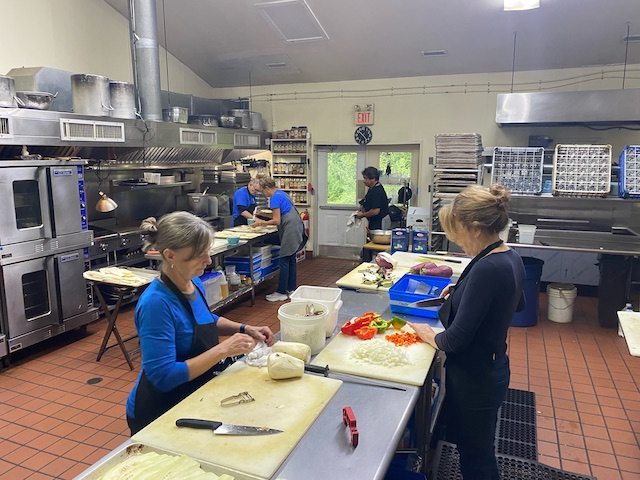From spring to fall, Fisherman’s Mark Social Services receives approximately 500 pounds of fresh, organic produce every week from local farms for dissemination at their Free MARKet food pantry. Distributing this quantity quickly is a challenge due to the limited shelf life of organic food. Additionally, certain produce that is plentiful during the summertime becomes scarce during the winter months, causing prices to rise and making those items less attainable for program participants who are often already struggling to make ends meet and keep nutritious food on the table. The Zero Waste Program, launched in August, attempts to address that challenge by avoiding waste while simultaneously addressing food insecurity.
“Our objective is to offer healthy food options to our program participants year-round, not just during harvest season,” said Jennifer Williford, Executive Director of Fisherman’s Mark. Considering the surplus during the warmer months, and the shortage of healthy produce during the colder months, the nonprofit’s solution was to partner with HollyHedge Estate, a premier destination and event center in New Hope and long-time supporter of Fisherman’s Mark. Under the supervision of Chef, Jose Calderon, the surplus is prepared and preserved at the HollyHedge kitchen for future use. “This program is possible because of the generosity of HollyHedge,” Williford said.
“When we receive an order of produce, we set aside excess items that we have in stock to prevent them from losing their quality and spoiling,” explained Ricardo Zapata, Director of Operations for Fisherman’s Mark. “To preserve their freshness, we process and pack each item in the most appropriate way. Under the guidance of Chef Jose at HollyHedge, our team of volunteers peels, cuts and chops. Chef Jose then determines the best options for creating the ingredients into delicious dishes.” The final product gets vacuum-sealed for freezing. “The volunteers not only assist in the process, but also enhance their culinary skills,”
“One of the challenges of working in the food industry is that there is so much waste of nutritious food that doesn’t make its way to people who need it,” said Tim Luccaro, General Manager of HollyHedge Estate. “The work that Fisherman’s Mark does in partnership with local restaurants, grocery stores and farms diverts food away from the mixed waste stream while also combating food insecurity which has risen from inflation. For many members of our community, inflation has caused the price of the most basic food items to increase beyond their budgets. Fisherman’s Mark provides critical support to a huge cross-section of our neighbors.”
The next step for Fisherman’s Mark is to survey local restaurants, bakeries, stores, etc. to find out if they have a surplus of food that they would be willing to donate to the Zero Waste Program. Future plans for the program will also include expanding into canning fruits and vegetables, as well as breaking down bulk donations. “For example, a pack of 30 pounds of meat can be cut and packed into 1-pound pouches,” Zapata said. “In the process, we will hopefully be educating new generations about old methods of food conservation, such as the blanching process, and encouraging them to explore new recipes.”
“So far, the Zero Waste Program has produced items such as peach sauce, zucchini bread, eggplant lasagna and Giardinera,” Williford noted. {Giardinera is a relish-like condiment made from a mix of cauliflower florets, carrots, bell peppers and celery.} “We’re an organization that strives to maximize efficiency and reduce waste at every level, whether it’s a financial donation from a generous supporter or a bushel of peaches donated from a local farm.”

“We are committed to this program for the long haul,” Luccaro said. “We need to break down the barriers that cause food insecurity. This program is a huge step forward toward accomplishing that.”
Fisherman’s Mark is a nonprofit 501(c)3 organization that provides help when help is needed with responsive programs and services that provide stability, health, and education. For more information, visit www.fishermansmark.org
